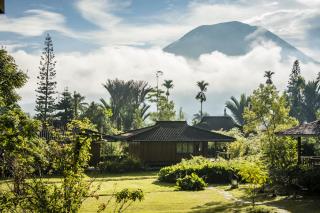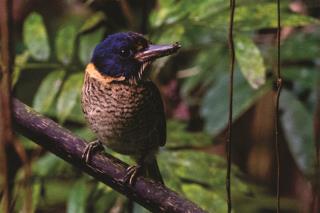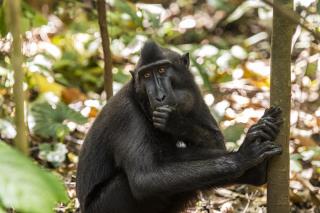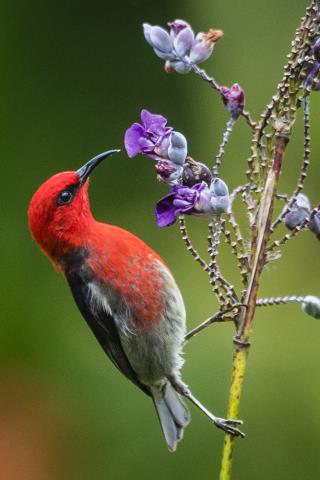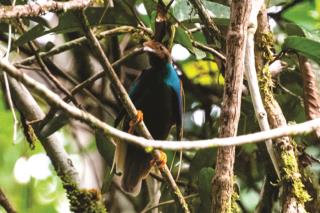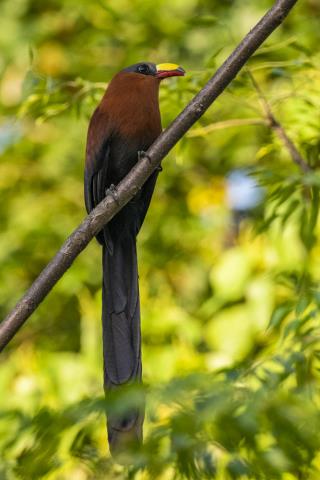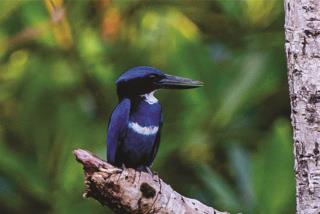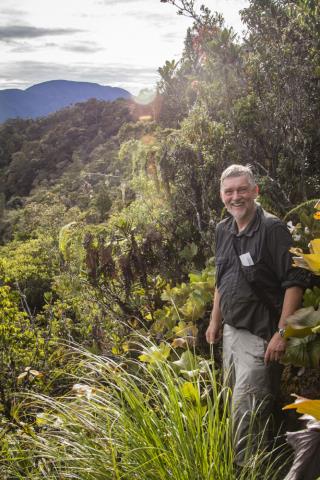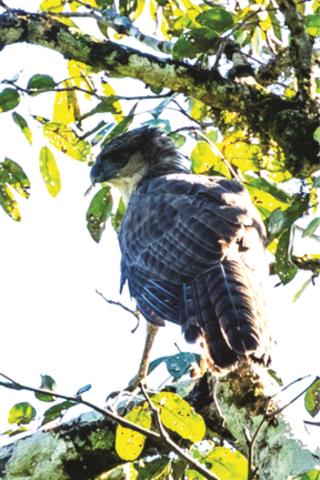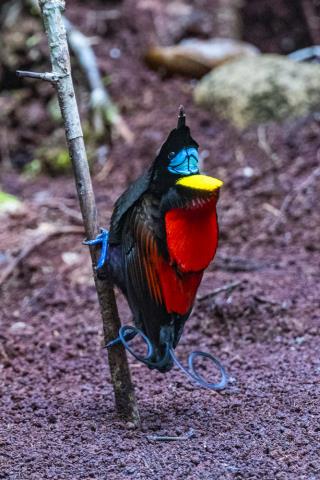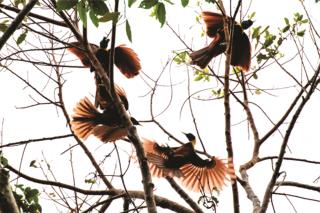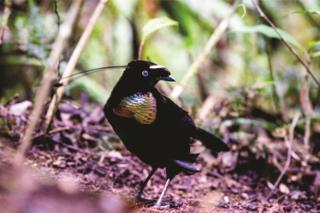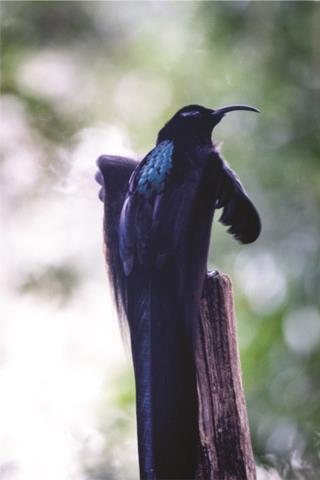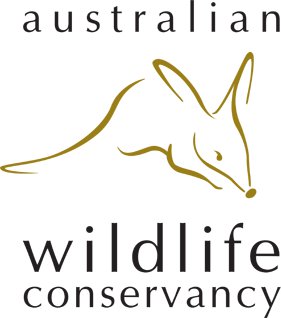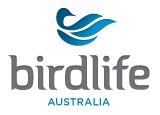Experience Wild Indonesia
22 day's birding around Sulawesi, Ternate, Halmahera and New Guinea
- Twenty-two day tour, twenty-one night tour (21 days birding) Without doubt, Sulawesi is one of the most attractive islands in the Indonesian Archipelago. With spectacular scenery and a host of endemic and near-endemic birds, it is a place that all serious birders and naturalists must visit. Experience the Wild is delighted to partner with renowned bird guide David Bishop and offer you a wonderful wildlife experience in Indonesia and West Papua. David is a veteran of decades of bird guiding in PNG, West Papua, Indonesia and other parts of the world. He speaks fluent Tok Pisin and Bahasa (Indonesian) and enjoys a very good rapport with local people. Learn more about this part of Indonesia here. David Bishop and Mike Jarvis are your guides. Please see guide bios here.
- Key species - Birds of Paradise!!! including Wallace's Standardwing, Wilson’s Bird-of-paradise, Red Bird of Paradise, Long-tailed Paradigalla, Arfak Astrapia and Buff-tailed Sicklebill, plus hornbills, woodpeckers, kingfishers and many other species you have never seen before! Mammals: Black Crested Macaque, Bear Cuscus
- Will this tour suit me? In the past the very poor quality of hotels at almost all the birding spots made many people think twice about visiting this country, and many simply stayed away. David Bishop Bird Tours has made a special effort to seek out better accommodations and happily this has been largely successful. We will commence our expedition with a night in the lovely lodge settled in the cool of the uplands of northeast Sulawesi. The following few nights will be based at a local guesthouse right in the midst of the birding, with a/c, western bathroom facilities and good food. The night before we fly to Ternate will be at a very attractive four-star hotel in Manado. On the island of Halmahera we will stay at the Weda Dive Resort a superb facility located on the east coast and surrounded by gorgeous forest and super bio-diverse coral reefs. Sorong at the western tip of New Guinea hosts several 3-4 star hotels with all the associated good facilities. On the island of Waigeo we will stay at a local guesthouse, which has air-conditioning, a western bathroom and comfortable bedroom and is close to the lodges private beach. We will do our utmost to make your experience as comfortable as possible but a/c, flat screen televisions, massages, and wireless internet may not be available at some of the more out of the way locations. Please go to the Indonesia Expedition page for more detailed information and travel tips.
- Cost - $ POA per person twin share, single person supplement (US$-)
- 2023 dates - This tour is on hold due to the Covid-19 pandemic, we hope to be able to confirm dates for 2023 in the near future.
- Book this tour - This tour is limited to a maximum of only eight participants. Please email us if you would like to be informed when dates are locked in for this tour.
Itinerary
Experience Wild Indonesia 22 day birding tour – May 11-June 2, 2023
Day 1, May 11: Arrive Jakarta.
After a long flight it will be wonderful to arrive at a comfortable and very efficiently operated hotel with lovely birdy grounds to explore.
NIGHT: International Bandara Hotel, Jakarta
Day 2, Fly Jakarta to Manado and drive to Tangkoko Nature Reserve
After some relaxed early morning birding in the grounds of our hotel and a deliscious buffett breakfast we will take a mid-day flight to Manado (flight GA600 depart 1100, arrive 1530) located at the north eastern tip of Sulawesi. From Manado airport we will drive to Tangkpko arriving at about 1800hrs.
NIGHT: Tangkoko Nature Reserve
Days 3-4, May 13-14: Explore Tangkoko Nature Reserve
This fabulous reserve encompasses an extensive tract of lowland and hill forest right at the very tip of the Minahassa Peninsula. Here we have the opportunity to experience some of the best birding and wildlife experiences in Sulawesi. We have two days to take in all this park has to offer and this should give us an excellent chance to see the endangered Black Crested Macaque – researchers have partially habituated one group; the diminutive, nocturnal Spectral Tarsier and the bizarre Bear Cuscus, the world’s largest marsupial phalanger.
David first explored Tangkoko as long ago as 1981! Gosh how time flies. The birding here is wonderful with nearly 50 regional endemics present in addition to many, many others. Some of the species we may find include: Tabon Scrubfowl, Sulawesi Serpent-Eagle, Sulawesi Hawk-Eagle which visually mimics the Barred HoneyBuzzard – or is it the other way around?, Spot-tailed Goshawk, Sultan’s Cuckoo-Dove and the very handsome White-faced CuckooDove which belongs to the genus Turacoena; Gray-cheeked Green Pigeon, Maroon-chinned and Black-naped fruit doves, Green and Silver-tipped imperial-pigeons, Bay Coucal, Black-billed Koel, the very smart-looking Yellow-billed Malkoha, Sulawesi Scops-Owl and Ochre-bellied Boobook – both sometimes at their daytime roost; Sulawesi Nightjar, the adorable and gem-like Sulawesi DwarfKingfisher; Lilac-cheeked, Black-billed, Ruddy and Green-backed kingfishers, Sulawesi Dwarf and the mighty Painted (Knobbed) hornbills, Ashy Woodpecker, Golden-mantled and Yellowish-breasted racquet-tails, Blue-backed Parrot, Sulawesi and Pygmy hangingparrots, Sulawesi Pitta, Finch-billed and Sulawesi Crested mynas – both very striking endemics and the secretive Rusty-backed Thrush.
Some of the more widespread species we are likely to encounter in secondary forest or adjoining grassland habitats include: the elusive Stephan’s Dove, Lesser Coucal, the introduced Sooty-headed Bulbul, Black-naped Oriole, Slender-billed Crow, Flyeater, White-breasted Wood-Swallow, Plain-throated (or Brown-throated) and Olive-backed sunbirds, and Black-fronted White-eye. Along the coast, or during our boat trip, we may well encounter Great and Lesser frigatebirds, Pacific Reef Egret, Striated (or Little) Heron, Brahminy Kite, the huge White-bellied Sea-Eagle, Common, Black-naped, White-winged, Whiskered and Little terns, Pink-necked Green Pigeon and more species of kingfishers in the form of Collared, Sacred and Common. We will also make a very special effort to track down the almost mythical Minahassa Masked-Owl.
NIGHTS: Tangkoko Nature Reserve
Day 5, May 15: Tangkoko to Tomohon
We will depart very early this morning and drive up into the surounding hills above Manado to the ancient volcano of Mount Mahawu. Here amidst lovely upland forests we will enjoy our only opportunity to encounter a suite of Sulawesi montane birds including some rather nice endemics. With a bit of luck we may see such gems as: Isabelline Bush-hen, the spectacular Yellow-billed Malkoha, Sulawesi Pygmy Woodpecker, Grey-rumped Treeswift, Caerulean Cuckoo-shrike, Sulawesi Triller, Sulphur-bellied Whistler, Sulawesi Drongo, Pale-blue Monarch, Citrine Canary-Flycatcher, Island Verditer Flycatcher, Sulawesi Babbler, Sulawesi Leaf-Warbler, Mountain Tailorbird, Black-crowned and Mountain white-eyes, Yellow-sided and Grey-sided flowerpeckers and Black-faced Munia. With a great deal of luck we may find the elusive Scaly-breasted Kingfisher.
As the day warms up we will retreat to the very lovely Gardenia Hotel and our accommodations for the night. here in a pleasantly refreshing climate we will find ourselves located beneath the ramparts of a towering volcano, Mount Lokon. this is a delightful place to relax, wander in luxuriant gardens and familiarise ourselves with the birds and butterflies of Sulawesis higher elevations. during the afternoon we may well return to Mount Mahawu for another opportunity to seek out some of the mountains more elusive species.
NIGHT: Gardenia Hotel
Day 6, May 16: Drive from Tomohon to Manado and fly to Ternate, boat and drive to Halmahera
This will be a long but fascinating travel day. This morning we will depart before dawn and drive down to Manado airport. From there we will take a mid-morning flight eastwards to the tiny, volcanic island of Ternate. Our flight will indeed be dramatic for Ternate is little more than a huge smoking volcano, which rises to over 1700m. The perfectly shaped cone, which last erupted in 1987 – I was there! is one of a chain of small volcanoes which guard the western approaches to Halmahera. Ternate was formerly of vital importance as one of the world’s few sources of cloves, but today it is a little visited backwater with only the crumbling remains of its colonial past reminding us of its one-time international significance. Here we are at last, in the heart of the Spice Islands. This fascinating, mystical island with its extensive plantations of Nutmeg and Cloves provided a powerful inducement to early European exploration of the ‘East Indies’.
From Ternate we will take either a speedboat or the ferry over to Halmahera and from the coast make the long drive through some interesting country, lovely landscapes including superb forest to our pleasant accommodations at Weda Dive Resort.
NIGHT: Weda Dive Resort
Days 7 – 9, May 17-19: Explore Halmahera
At long last we have arrived on the mystical island of Halmahera once known back in the days of A. R. Wallace as Gilolo. Halmahera is by far the largest island of the Moluccan archipelago (now known as Maluku) with a strikingly contorted shape. The Moluccas are famed as the ‘Spice Islands’ and in the 15th and 16th centuries completely dominated the world trade in cloves, nutmeg and mace. Halmahera consists largely of a series of hills that were, until recently, clothed in relatively undisturbed rainforest. Pressure on the land here is becoming intense and many of the island’s fantastic endemics are sadly now threatened by forest clearance. Typically the local population is concentrated on the coastal plains where coconut and sago palm plantations are interspersed with areas of grassland and scrub. Fortunately, the Indonesian government has set aside some large areas of primary forest in the form of national parks and reserves. In addition extensive areas of forest still persist on the steeper or more accessible slopes.
Halmahera lies further to the east of Wallace’s Line than Sulawesi and consequently its avifauna contains a higher proportion of Australasian elements. For the next three days we will explore this interesting community as well as treating ourselves to some very special and little known birds including the famed Wallace's Standardwing. We know of at least two display sites and will spend several hours one morning watching these remarkable birds go about their courtship. This very peculiar species of bird of paradise was thought to be extinct until rediscovered by David Bishop in 1983. David’s subsequent discovery of a display site of this species was the setting for a David Attenborough/BBC documentary and the subject of a scientific paper published by David Bishop.
Other birds we may see here include: Dusky and, if we are very lucky, Moluccan scrubfowl, Pacific Baza, Gurney's, Black and Pygmy eagles, Rufous-collared Sparrowhawk, Moluccan Goshawk, Blue-capped, Grey-hooded and Scarlet-breasted fruit-doves, Spectacled and Cinnamon-bellied imperial-pigeons, Moustached Tree-Swift Goliath Coucal – the world’s largest species; Moluccan Scops-owl, Moluccan Boobook, Moluccan Owlet-nightjar, Sombre, Beach, Azure, Blue-and White and Variable Dwarf kingfishers, the attractive Common Paradise-Kingfisher, Blyth's Hornbill, Red-flanked Lorikeet, Chattering Lory (declining owing to trapping), Moluccan Hanging-Parrot, Greatbilled Parrot, White Cockatoo, Violet-necked Lory, Red-cheeked and Eclectus Parrots, and the lovely Moluccan King Parrot, the exquisite Ivory-breasted Pitta – very elusive but well worth the chase; Moluccan, Halmaheraand White-bellied cuckoo-shrikes, Common Cicadabird, Rufous-bellied Triller, Northern Golden Bulbul, Island Leaf Warbler (the local form may well be split in future as Halmahera Leaf Warbler), Slaty and Shining flycatchers, the delightful White-naped and Spectacled monarchs, Willie Wagtail, Black-chinned (split from Golden) and Drab whistlers, Dusky Oriole, Paradise Crow - a true birdof-paradise most similar to the Manucodes; Long-billed Crow, White-streaked Friarbird, Moluccan and Metallic starlings, Halmahera Flowerpecker, and Creamy-throated White-eye. We will also make a special effort to find such extreme rarities as Nicobar Pigeon, Azure Roller and the almost legendary Invisible Rail.
NIGHT: Weda Dive Resort
Day 10, May 20: Return to Ternate, fly to Manado.
After a final morning’s birding we will return to Ternate where we will connect with our return flight to Manado, Sulawesi. As we cross the sound under the shadow of Tidore we should be alert for whatever moves, including: Bulwer’s Petrel and both Bridled and Greater Crested terns, Brown and Redfooted boobies, Spinner Dolphin and Short-finned Pilot Whale.
NIGHT: Novatel Hotel, Manado, Sulawesi
Day 11, May 21: Fly Manado to Manokwari at the western tip of New Guinea
Taking our leave of the ‘Spice Islands’ we will head eastwards, crossing the imaginary Weber’s Line before setting down in the township of Mankwari. If time permits – and it certainly should …… we will explore nearby hill-forests for our first New Guinea birds. Here again we will be immersed in a completely different avifauna. Some of the birds we may encounter here include: Zoe and Pinon’s imperial pigeons, Claret-breasted, Orange-bellied and Superb fruit-doves, Brush Cuckoo, Rufous-bellied Kookaburra, Dollarbird and with great luck the rather scarce Black Lory.
NIGHT: Aston New Hotel, Manokwari, West Papua.
Day 12, May 22: Explore the Arfaks
We will commence our exploration of the Arfaks by birding an area of lowland forest located less than 30 minutes from our attractive hotel. This is a great spot for the spectacular Pesquet’s or Vulturine Parrot in addition to Blyth’s Hornbill and many of the lowland species for Sorong, plus if we are very lucky, Rufous Monarch. After lunch we will drive up into the Arfak Mountains to an elevation of circa 5000 feet and settle into our surprisingly comfortable if a little rustic accommodations.
NIGHT: Arfak Mountains
Days 13 – 16, May 23-26: Birding the Arfak Mountains
We will have excellent opportunities to observe Magnificent and Superb birds of Paradise from a hide specially built to observe their displays. In addition there will be similar opportunities to observe Arfak Bowerbird attending its remarkable bower; Black Sicklebill displaying at the break of dawn; the extraordinary Arfak Parotia, with its ballerina-like display; plus the very localized Long-tailed Paradigalla, Arfak Astrapia and Buff-tailed Sicklebill. Other exciting possibilities include: White-throated Pigeon, White-striped Forest-Rail, Bronze Ground Dove, Rufescent Imperial Pigeon, Josephine’s, Papuan and Yellow-billed lorikeets, Bluecollared Parrot, Red-breasted Pygmy Parrot, White-eared Bronze Cuckoo, Vogelkop and Grey-green scrubwrens, Smoky, Ashy, Garnet, Green-backed and White-rumped robins, Olive-crowned Flowerpecker, Black-fronted White-eye, Dwarf and Rufous-sided honeyeaters, and Mountain Meliphaga, Masked Flame Bowerbird, Dwarf, Sclater’s and endemic Vogelkop whistlers, Spotted JewelBabbler; with a modicum of luck we may find a day roost of a magical-looking Feline or even a Mountain Owlet-Nightjar, Black Pitohui, Orange-crowned Fairy-wren and at flowering trees Western Smoky Honeyeaters, and Cinnamon-browed and the endemic Vogelkop Melidectes.
NIGHTS: Arfak Mountains
Day 17, May 27: Return to Manokwari and fly to Sorong.
After some final birding we will drive down to Manokwari in good time to catch our afternoon flight to Sorong on the very western most tip of New Guinea.
NIGHT: Swisse Belle Hotel, Sorong, West Papua.
Day 18, May 28: Explore the Tamrau Mountains and Waigeo
These magnificent forests are very poorly explored; local forest people advise me that Northern Cassowary is still present – now confirmed ---- wouldn’t that be wonderful and similarly the magnificent Western Crowned Pigeon – encountering either species would be an incredible coup; Lesser, King and Twelve-wired birds of paradise are all present and we shall do our very best to find these gems; Blyth’s Hornbill, Yellow-billed and Blue-black kingfishers, Palm Cockatoo, Papuan and Hooded pittas, Golden Cuckoo-shrike, the secretive Blue Jewel-babbler, Emperor Fairy-Wren, Rusty MouseWarbler – colloquially known as the ‘Bush Telegraph’; the pugnacious New Guinea Friarbird; Yellow-bellied Gerygone, Black Berrypecker, Olive-crowned Flowerpecker, Lowland Peltops, Hooded and Black butcherbirds, Northern Variable Pitohui, Golden, Rufous (if we are lucky) and Frilled monarchs, Yellow-breasted Boatbill, several species of fantails and thicket-fantails, the bizarre Grey Crow, Trumpet and Glossy-mantled manucodes (believe it or not both are regarded as birds of paradise!); Black-sided Robin, Spangled Drongo, Metallic Starling, the lovely Golden Myna and Streak-headed Mannikin. During David Bishop 2018 tour tour they saw two New Guinea Harpy Eagles right by the road on two different mornings. As the day heats up and bird activity diminishes we will return to our hotel to cool down, freshen up and enjoy a good lunch and some well-deserved r&r before heading out again to yet another great birding site.
NIGHT: Swisse Belle Hotel, Sorong, West Papua.
Day 19, May 29: AM Lowland Forest Birding; Ferry to Waigeo in the Raja Ampats (Four Kings)
We will almost certainly return to the lowland forest because there are inevitably several very special birds that we missed yesterday or want to see better or even to try and photograph. After lunch we will take a public ferry accross to the huge island of Waigeo and our lovely beachside lodge surrounded by tropical forest.
NIGHT: Waiwo Dive Resort
Days 20-21, May 30-31: Explore Waigeo Island
On our first morning here we will make an early start with a pre-dawn drive inland along a wonderfully forested track to a specially constructed blind which will permit us to observe one of the most beautiful birds on Earth – displaying Wilson’s Bird-of-Paradise!! We will allow ourselves plenty of time to relax and really enjoy this fabulous bird, and for the photographers amongst us, this will be the opportunity of a lifetime! To sit in these hides watching these gorgeous birds, while hornbills and cockatoos call overhead, and with a supporting cast of imperial pigeons, Common Paradise Kingfishers and Hooded Butcherbirds all calling in the surrounding forest, is a fabulously evocative experience and certainly one of the major highlights of this entire bespoke tour.
Once we are fully satiated with the Wilson’s Bird-of-paradise, we will spend the rest of the morning birding along a lovely forested road with little or no traffic to disturb us. As the day heats up and bird activity diminishes we will retreat to the cool and comfort of our guest house, affording us an opportunity to rest, relax, clean up and reflect on what should have been a very special morning indeed!
During the afternoon we will likely spend more time on Waigeo, searching for the peculiar Brown-headed Crow among a suite of other exciting birds. There will also be the opportunity for some superb snorkeling should you wish.
During our second morning on Waigeo we will again arise early and wend our way into the forest to observe the stunning Red Bird-ofParadise performing at its display tree. If time permits we will search for a number of other New Guinea species including Dusky Megapode (Scrubfowl), Great-billed Heron, Osprey, White-bellied Sea Eagle, Brahminy Kite, possibly the white morph of Variable Goshawk, chances for Barred Rail (here at the eastern edge of its range), stunning Claret-breasted Fruit Dove, Pied Imperial Pigeon, Great Cuckoo-dove, Black-capped Lory, Little Bronze and Brush cuckoos, Papuan Frogmouth, Papuan Boobook, Large-tailed Nightjar, Rufous-bellied Kookaburra, Common Paradise Kingfisher, Glossy Swiftlet, Moustached Treeswift, Hooded Pitta, Spotted Honeyeater, Helmeted Friarbird, Tropical Scrubwren, and Yellow-bellied and Pygmy longbills.
NIGHT: Waiwo Dive Resort
Day 22, June 1: AM Waigeo Island, PM return to Sorong.
If it can be arranged will also visit one or two tiny offshore islets for small island/“supertramp” species such as the local form of Whitebibbed Fruit Dove (recently split by some authorities as Moluccan Fruit Dove), Spice Imperial Pigeon – now split from the birds on Biak, possibly Spectacled Imperial Pigeon if we are very lucky, Violetnecked Lory, Great-billed Parrot, Beach Kingfisher, Varied Honeyeater, a very distinctive and possibly as-yet-undescribed honeyeater most likely closely related to Olive Honeyeater, Arafura Fantail, Island Monarch, Island Whistler and Lemon-bellied White-eye.
During the late afternoon we will visit ascrubby area of mangroves where we have a reasonable chance for the spectacular Blue-black Kingfisher and Orange-fronted Fruit-Dove
NIGHT: Swisse Belle Hotel, Sorong, West Papua.
Day 23, June 2: Fly from Sorong to Jakarta
After breakfast at the hotel in Sorong and and lunch in flight our tour concludes apon arrival back at Jakarta
Please Note: The above itinerary is based on the outcomes of many previous tours to the areas described by David Bishop. Each season is different and as various wildlife observing opportunities arise and depending on the preferences of the group, adjustments will be made.
Inclusions - Accommodation double/twin sharing in standard rooms, travel in air-conditioned vehicle with an experienced English speaking chauffeur, local ornithologist and EtW guide, entrance fees to all sites and national parks mentioned and jeep hire, breakfast and dinners each day including group breakfast on day 18, bottled water available at all times. Forty page booklet - combined checklist, itinerary, map and journal. Tips are customarily paid to local guides, jeep drivers, chauffeurs and hotel staff, this is a hidden cost and is completely covered on your behalf by Experience the Wild.
Exclusions - Pre and post tour accommodation, flights to and from Jakarta, airport tax, travel insurance, visa fees, items of a personal nature such as drinks, laundry, etc. entry fees for sites mentioned other than included, early check-in and late check out.
Group Tour -$ POA per person twin share, single person supplement (US$-)
Please click here to register your interest in this tour
All prices are in Australian dollars. Please click here for conversion to your currency.
Booking Procedure - You can book directly using our secure online booking site by clicking here. Payment options are Visa, Mastercard, Paypal or Bank Transfer. A 20% deposit secures the booking, the balance is due 90 days prior to start of tour. Please feel free to contact us if you have any queries regarding the tour.
Further Information - Click here to download our 'What to expect on an Experience the Wild tour' document. Our Terms and Conditions document outlines our cancellation and refund policy. Email enquiries@experiencethewild.com.au or ring Jenny or Mike on 0400 404 058
Important information for this tour - Please read Indonesia Expedition
Birdwatching Ethics
Most birdwatchers are cognizant of the needs of birds and avoid causing any undue stress to their avian subjects. We don't use playback to bring birds closer and we keep a respectable distance from nests. There are photos of birds at the nest on this website. These are taken from a reasonable distance with aid of powerful zoom lenses and in most cases, from an established pathway. Also, we don't chase or deliberately flush birds. Quietly stalking them will yield better results, but even this can be interpreted by birds as predatory behaviour. The most satisfying close encounters are had when birds move in to range of their own volition when we wait patiently in the one location. We never place food to bait birds to come in to range. Guides have the benefit of an intimate familiarity with local species and habitats and can set you up to get great results without resorting to questionable practises. Guests are encouraged to speak up if they see any situation that could be detrimental to birds or habitat while on tour.

